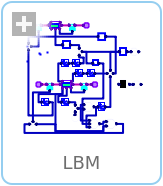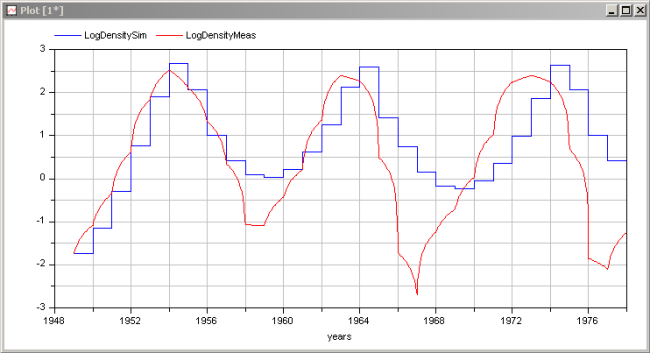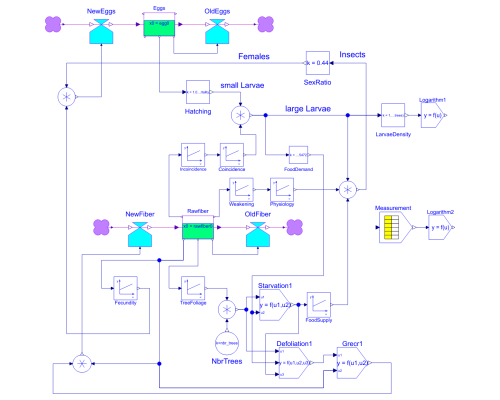WOLFRAM SYSTEM MODELER
LBMLarch bud moth population dynamics model |
|
Diagram
Wolfram Language
SystemModel["SystemDynamics.PopulationDynamics.LarchBudMoth.LBM"]

Information
References:
- Cellier, F.E. (1991), Continuous System Modeling, Springer-Verlag, New York, ISBN: 0-387-97502-0, 755p.
- Fischlin, A. and W. Baltensweiler (1979), "Systems Analysis of the Larch Bud Moth System. Part I: The Larch - Larch Bud Moth Relationship," Mitteilungen der Schweizerischen Entomologischen Gesellschaft, 52, pp.273-289.
Simulate the model across 29 time units (years) and plot the simulated and the measured data together against the calendar years.

Parameters (5)
| wintermortality |
Value: 0.5728 Type: Real Description: Percentage of eggs dying during the winter |
|---|---|
| biomass |
Value: 91.3 Type: Mass Description: Dry needle biomass per tree |
| nbr_trees |
Value: 511147 Type: Integer Description: Number of trees |
| egg0 |
Value: 4765975 Type: Integer Description: Initial number of eggs |
| rawfiber0 |
Value: 15.0 Type: Real Description: Initial rawfiber |
Outputs (2)
| LogDensitySim |
Type: Real Description: Simulated logarithmic larvae density |
|---|---|
| LogDensityMeas |
Type: Real Description: Measured logarithmic larvae density |
Components (33)
| Source1 |
Type: Source Description: This is the (dummy) source model of System Dynamics |
|
|---|---|---|
| NewEggs |
Type: Rate_1 Description: Unrestricted rate element with one influencing variable |
|
| Eggs |
Type: DiscreteLevel Description: Discrete level of the System Dynamics methodology |
|
| OldEggs |
Type: Rate_1 Description: Unrestricted rate element with one influencing variable |
|
| Sink1 |
Type: Sink Description: This is the (dummy) sink model of System Dynamics |
|
| Hatching |
Type: Gain Description: Gain factor |
|
| Rawfiber |
Type: DiscreteLevel Description: Discrete level of the System Dynamics methodology |
|
| NewFiber |
Type: Rate_1 Description: Unrestricted rate element with one influencing variable |
|
| Source2 |
Type: Source Description: This is the (dummy) source model of System Dynamics |
|
| OldFiber |
Type: Rate_1 Description: Unrestricted rate element with one influencing variable |
|
| Sink2 |
Type: Sink Description: This is the (dummy) sink model of System Dynamics |
|
| Incoincidence |
Type: Linear Description: Linear function |
|
| Coincidence |
Type: Linear Description: Linear function |
|
| Prod_2_1 |
Type: Prod_2 Description: Product of two influencing factors |
|
| Weakening |
Type: Linear Description: Linear function |
|
| Physiology |
Type: Linear Description: Linear function |
|
| TreeFoliage |
Type: Linear Description: Linear function |
|
| Prod_2_2 |
Type: Prod_2 Description: Product of two influencing factors |
|
| NbrTrees |
Type: Const Description: A constant factor |
|
| Starvation1 |
Type: Starvation Description: Starvation function |
|
| FoodDemand |
Type: Gain Description: Gain factor |
|
| FoodSupply |
Type: Linear Description: Linear function |
|
| Prod_3_1 |
Type: Prod_3 Description: Product of three influencing factors |
|
| SexRatio |
Type: Gain Description: Gain factor |
|
| Fecundity |
Type: Linear Description: Linear function |
|
| Prod_2_3 |
Type: Prod_2 Description: Product of two influencing factors |
|
| Defoliation1 |
Type: Defoliation Description: Defoliation function |
|
| Grecr1 |
Type: Grecr Description: Raw fiber content function |
|
| Prod_2_4 |
Type: Prod_2 Description: Product of two influencing factors |
|
| LarvaeDensity |
Type: Gain Description: Gain factor |
|
| Logarithm1 |
Type: Logarithm Description: Logarithmic transformation |
|
| Measurement |
Type: Tabular Description: Tabular function |
|
| Logarithm2 |
Type: Logarithm Description: Logarithmic transformation |

